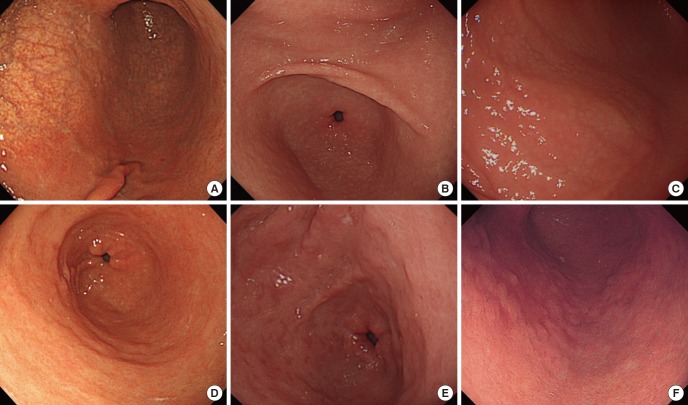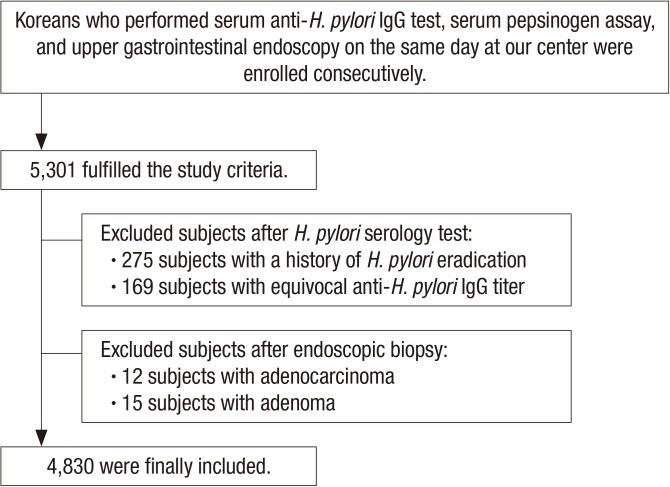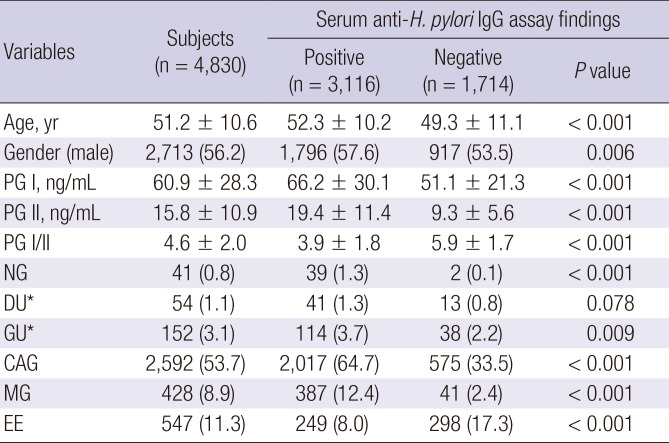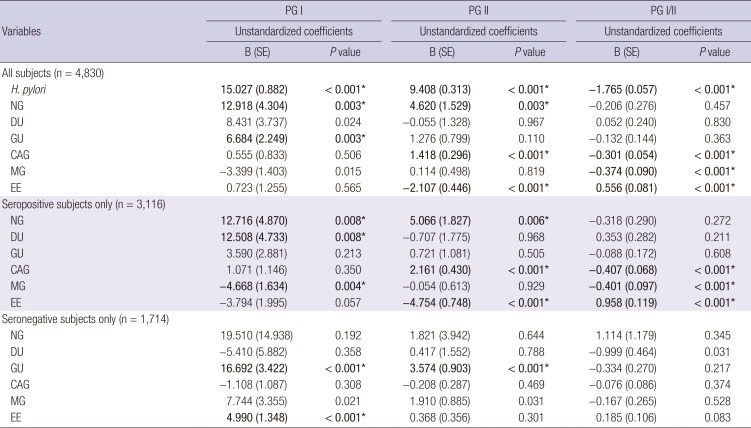1. Kang HY, Kim N, Park YS, Hwang JH, Kim JW, Jeong SH, Lee DH, Jung HC, Song IS. Progression of atrophic gastritis and intestinal metaplasia drives
Helicobacter pylori out of the gastric mucosa. Dig Dis Sci. 2006; 51:2310–2315. PMID:
17080249.
2. Testoni PA, Bonassi U, Bagnolo F, Colombo E, Scelsi R. In diffuse atrophic gastritis, routine histology underestimates
Helicobacter pylori infection. J Clin Gastroenterol. 2002; 35:234–239. PMID:
12192199.
3. Storskrubb T, Aro P, Ronkainen J, Vieth M, Stolte M, Wreiber K, Engstrand L, Nyhlin H, Bolling-Sternevald E, Talley NJ, et al. A negative
Helicobacter pylori serology test is more reliable for exclusion of premalignant gastric conditions than a negative test for current
H. pylori infection: a report on histology and
H. pylori detection in the general adult population. Scand J Gastroenterol. 2005; 40:302–311. PMID:
15932171.
4. Hahn M, Fennerty MB, Corless CL, Magaret N, Lieberman DA, Faigel DO. Noninvasive tests as a substitute for histology in the diagnosis of
Helicobacter pylori infection. Gastrointest Endosc. 2000; 52:20–26. PMID:
10882957.
5. Shin CM, Kim N, Lee HS, Lee HE, Lee SH, Park YS, Hwang JH, Kim JW, Jeong SH, Lee DH, et al. Validation of diagnostic tests for
Helicobacter pylori with regard to grade of atrophic gastritis and/or intestinal metaplasia. Helicobacter. 2009; 14:512–519. PMID:
19889068.
6. Nardone G, Rocco A, Staibano S, Mezza E, Autiero G, Compare D, De Rosa G, Budillon G. Diagnostic accuracy of the serum profile of gastric mucosa in relation to histological and morphometric diagnosis of atrophy. Aliment Pharmacol Ther. 2005; 22:1139–1146. PMID:
16305728.
7. Song HJ, Jang SJ, Yun SC, Park YS, Kim MJ, Lee SM, Choi KD, Lee GH, Jung HY, Kim JH. Low levels of pepsinogen I and pepsinogen I/II ratio are valuable serologic markers for predicting extensive gastric corpus atrophy in patients undergoing endoscopic mucosectomy. Gut Liver. 2010; 4:475–480. PMID:
21253295.
8. Choi HS, Lee SY, Kim JH, Sung IK, Park HS, Shim CS, Jin CJ. Combining the serum pepsinogen level and
Helicobacter pylori antibody test for predicting the histology of gastric neoplasm. J Dig Dis. 2014; 15:293–298. PMID:
24602176.
9. Park SY, Lim SO, Ki HS, Jun CH, Park CH, Kim HS, Choi SK, Rew JS. Low pepsinogen I level predicts multiple gastric epithelial neoplasias for endoscopic resection. Gut Liver. 2014; 8:277–281. PMID:
24827624.
10. Nomura S, Ida K, Terao S, Adachi K, Kato T, Watanabe H, Shimbo T; Research Group for Establishment of Endoscopic Diagnosis of Chronic Gastritis. Endoscopic diagnosis of gastric mucosal atrophy: multicenter prospective study. Dig Endosc. 2014; 26:709–719. PMID:
24698334.
11. Lee SY. Endoscopic gastritis, serum pepsinogen assay, and
Helicobacter pylori infection. Korean J Intern Med. 2016; 31:835–844. PMID:
27604795.
12. Rubenstein JH, Inadomi JM, Scheiman J, Schoenfeld P, Appelman H, Zhang M, Metko V, Kao JY. Association between
Helicobacter pylori and Barrett’s esophagus, erosive esophagitis, and gastroesophageal reflux symptoms. Clin Gastroenterol Hepatol. 2014; 12:239–245. PMID:
23988686.
13. Lee SY, Moon HW, Hur M, Yun YM. Validation of western
Helicobacter pylori IgG antibody assays in Korean adults. J Med Microbiol. 2015; 64:513–518. PMID:
25752852.
14. Iijima K, Kanno T, Koike T, Shimosegawa T.
Helicobacter pylori-negative, non-steroidal anti-inflammatory drug: negative idiopathic ulcers in Asia. World J Gastroenterol. 2014; 20:706–713. PMID:
24574744.
15. Lee JY, Kim N, Lee HS, Oh JC, Kwon YH, Choi YJ, Yoon KC, Hwang JJ, Lee HJ, Lee A, et al. Correlations among endoscopic, histologic and serologic diagnoses for the assessment of atrophic gastritis. J Cancer Prev. 2014; 19:47–55. PMID:
25337572.
16. Song HJ, Shim KN, Yoon SJ, Kim SE, Oh HJ, Ryu KH, Ha CY, Yeom HJ, Song JH, Jung SA, et al. The prevalence and clinical characteristics of reflux esophagitis in Koreans and its possible relation to metabolic syndrome. J Korean Med Sci. 2009; 24:197–202. PMID:
19399258.
17. Kitamura Y, Yoshihara M, Ito M, Boda T, Matsuo T, Kotachi T, Tanaka S, Chayama K. Diagnosis of
Helicobacter pylori-induced gastritis by serum pepsinogen levels. J Gastroenterol Hepatol. 2015; 30:1473–1477. PMID:
25974661.
18. Tu H, Sun L, Dong X, Gong Y, Xu Q, Jing J, Long Q, Flanders WD, Bostick RM, Yuan Y. Temporal changes in serum biomarkers and risk for progression of gastric precancerous lesions: a longitudinal study. Int J Cancer. 2015; 136:425–434. PMID:
24895149.
19. Chae H, Lee JH, Lim J, Kim M, Kim Y, Han K, Kang CS, Shim SI, Kim JI, Park SH. Clinical utility of serum pepsinogen levels as a screening test of atrophic gastritis. Korean J Lab Med. 2008; 28:201–206. PMID:
18594172.
20. Kim EH, Kang H, Park CH, Choi HS, Jung DH, Chung H, Park JC, Shin SK, Lee SK, Lee YC. The optimal serum pepsinogen cut-off value for predicting histologically confirmed atrophic gastritis. Dig Liver Dis. 2015; 47:663–668. PMID:
26077884.
21. He CY, Sun LP, Gong YH, Xu Q, Dong NN, Yuan Y. Serum pepsinogen II: a neglected but useful biomarker to differentiate between diseased and normal stomachs. J Gastroenterol Hepatol. 2011; 26:1039–1046. PMID:
21303408.
22. Gritti I, Banfi G, Roi GS. Pepsinogens: physiology, pharmacology pathophysiology and exercise. Pharmacol Res. 2000; 41:265–281. PMID:
10675278.
23. Seo JH, Lim CW, Park JS, Yeom JS, Lim JY, Jun JS, Woo HO, Youn HS, Baik SC, Lee WK, et al. Correlations between the CagA antigen and serum levels of anti-
Helicobacter pylori IgG and IgA in children. J Korean Med Sci. 2016; 31:417–422. PMID:
26955243.









 PDF
PDF ePub
ePub Citation
Citation Print
Print




 XML Download
XML Download